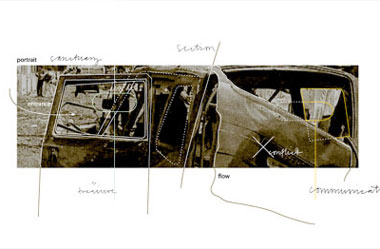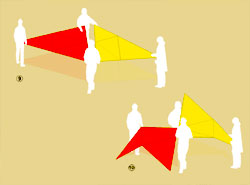Collaboration - PoP
PoP Project or Proposal
2002 summer
School of Architecture
Royal Institute of Technology, Stockholm
5 weeks summer course
"The PoP course does not entertain. It scratches, it provokes,
it frightens. It tells you things you don't want to know but then it twists
you inside out by saying, look harder and see the poignance, the beauty
of light dancing on life's edge, truth that is as simple and direct as
death."
PoP is a joint effort to critically explore a number of related issues
concerning the areas between concept and technology, model and representation
and process and proposal. The course will re-evaluate the components of
the architectural project through the use and abuse of digital tools and
the development of instrumental models.
Organisation
The structure of the course will be four tracks, each with a different
agenda. Each track will get an initiating package of references consisting
of theoretical and fictional texts, film clips, images etc. This mixed
material creates a common design environment of related concepts, terms
and phenomena - a starting point for discussions and a sphere of interest
for the different tracks. The projects will be developed in design groups
of three students, working on a task given in the track. Each group are
asked to once, apart from the final crit, during the course present their
work and its relationship to the environment. These presentations will
form weekly seminars for open discussions and sharing of emerging concepts.
Terminology
Site - a organization, a political system, a geographical or out of scale
site
Program - a prescription, fictional, a choreography, a secret plot
Concept - a platform for discussions, an obsession, a secret agenda, a
point of view
Structure - in time, set of relations, system architecture, network of
common ideas, social structures - fundamental relationships
Model - instrumental representation, carrier of concepts, simulacra, system,
Project - agenda, a group of related processes, statement, law, vision,
experiment
Proposal - tentative, trial/test, probe,
Lecturers
A number of lectures will be given during the course.
Guest lecturers include [preliminary]:
- Anders Johansson, architect, PhD-student at the KTH
- Ulrika Karlsson, architect, founding member of design collaborative
SERVO, PhD-student at the KTH
- Meike Schalk, architect, Phd-student at the KTH
- Erik Wingquist, architect, assisting teacher in the A+Url unit at KTH
Tutorials
Weekly tutorials are complemented by software assistance and applied introduction
lectures to a number of software packages.
Final presentation pop 020712
The pop-course is founded in the interest of the academic architectural project and its context, and the use of its potential. This five week course was set up to explore different themes and design environments, in order to find different potentials. Three different tracks were defined by references, in theory, literature and existing projects. Although dependent on texts to set up environments for discussion, the students were asked to do complete design projects, and stress issues as far as possible in five summer weeks. Projects range for explorations of attitude in a design-process, to actual suggestions for different "real" interventions, always with a mode of speculation.
As the media of the architect is more mediative [turbulent, virtual, non-physical, flexible, scale less, ...] than the media of architecture, it could act out in more places than buildings can. Its independency of scale makes it possible for the architect to use it for her/his own personal agenda, regardless if there is an economic or political support for it. The mediation of the virtual and physical realm is of special interest - does the project have a 'real' outcome? We know that the mediative aspects of buildings make them act beyond their physical boundaries. Ranging from press representations in photographs, text in a discourse or a cultural context, to the mere imaginary existing as memories in the minds of actual 'eyewitnesses'.
The most important aspect of the work is to lay a foundation for the
discussion today, which we will document and format.
The students have been encouraged to angle their work, and to seek potential
in different methods, find new territories for architectural intervention
and be aware of the positioning of their projects in the context of the
course.
We would like today's session to focus on similarities and differences
between the tracks, and discuss the potential of the individual project
as an academic exercise with possible application in more developed projects
or in practice.
The three different tracks can in a way be seen as three different projects, with a package of references acting out as the common site. The packages were put together as carefully as you would normally pick a site. They provide a kick-start and a fertile environment of loosely related concepts, terminologies and methods - a common ground for discussion. An attempt to blur the boundaries between 'project' and 'seminar'.The different concepts developed in these tracks have been discussed in the whole group during the three presentations during the course, during which all projects have been formatted and presented at its current state at least once.
To be able to make better use of digital tools it is necessary for the user and the creator to become critical and inventive. In the words of Flusser: Turning automatic apparatuses against automation. Teaching the habit of not using tools how they were ment to be used is only possible in a context [in this case architectural] - there must be a concept that can be mediated through the tool.
Track 1:
Man the player, was intitiated as rules for an [architectonic]
event.
The study of games were suggested means of understanding the nature of
an organisation or a set of rules.
The given references were:
- The Glass Bead Game, Herman Hesse
- an assortment of projects from the Oulipo literal movement
- a presentation of Situationist ideas and Constant 's New Babylon
- The Paranoid-Critical Method, as described in
Delirious New York
The brief suggested a phase were games would be studied, and later applied to reconstruct an architectural event rather than construct it, with a high grade of speculation.
Track 2:
Projecting ideas in other domains
Was looking for new Territories for architectural representation,
or new ways to act in architectural practice.
The students were asked to look for weak points in society, were minimal
effort would give maximum impact.
The used references were:
- Practice vs. Project, Stan Allen, on the relation between the academic
project and the practice.
- Terra Nova, Lebbeus Woods, on Woods view onhis visionary work.
- If on a Winter's Night a Traveller, Italo Calvino, on writing
- Vilém Flusser Glossary
- Culture Jamming, Naomi Klein, from No Logo
- Visual Intelligence, how we create what we see, Donald D. Hoffman, on
modes of representation.
The students were encouraged to look for situations and suggest means of acting according to the principles of jiu jitsu, a small investment of energy in such weak spot can set the opponent off- balance and unleash all her/his potential energy for the one's own benefit.
Track 3
self-surveillance
Subjective environments and Domestic interference,
This track starts off in a very introvert manner, with the monitoring
of one self, then later applied to create a possible narrative through
the merge of facts and fiction.
The references were:
- Case No. 00-17163, a project by Elizabeth Diller and Ricardo Scofidio
- Funes the Memorious, Jorge Luis Borges
- City of Glass, Paul Auster
- House of Asterion, Jorge Luis Borges
- Jealousy, Alain Robbe-Grillet
The fictional references were mainly focusing on how we see things, and the interplay between objective and subjective seeing.
During the length of the course a number of invited lecturers have presented their work, ranging from the academic setting, to exploratory architectural practice and art.
- work from the Machinic Processes in Architectural design, headed by Greg Lynn at the ETH in Zurich was presented as extremely focused formal research with certain pedagogical and representational qualities.
- Adam Somlai-Fischer presented his own work in the "Beta Test Butterflies"lecture
- Anders Johansson presented his research into models as projective device.
- Pablo Miranda lectured around "automata and architecture", the foundation for his own work.
- Malin Zimm presented work from her research
- Tobi Schneidler showed recent work from the Interactive Institute in ""meta.L.hyttan: building the hyper media edifice"
- Erik Wingqvist showed his diploma project on Malmö
- Ulrika Karlsson showed worked from servo, and the ideas behind their projects.
- Oskar Hafvenstein+Peter Tuvander speculated on new arenas of architectural practice in "windows of opportunities - looking at practice in advertisment to create new models for architectural practice"
- Jonas Dahlberg, artist, showed his work in the field of surveillance and architectural representation.
An important aspect of the reference material is to appropriate it for
ones own purposes. The projects may have very different characters, and
should possibly be seen as components of a greater whole.
As projects started to emerge, we found a range of possible ways of relating
to the brief and the package:
> Making the project equals literally investigating the potential package
in many ways, leading to a catalogue of possible agendas and methods that
can be projected on locations and situations found in a later stage.
> Initial assessment of the content of the package, leading directly
to construction of a new, potentially autonomous agenda with its own logic,
acting out in a self referential world.
For further information please visit the A+Url website:
http://www.arch.kth.se/pop
Teachers:
Pablo Miranda, Daniel Norell, Jonas Runberger, and Adam Somlai-Fischer
Selected student works
Belief Structures
Maria Sigeman, Eveliina Säteri

RTS
Hernán Concha Emmrich, Linnea Holmberg

